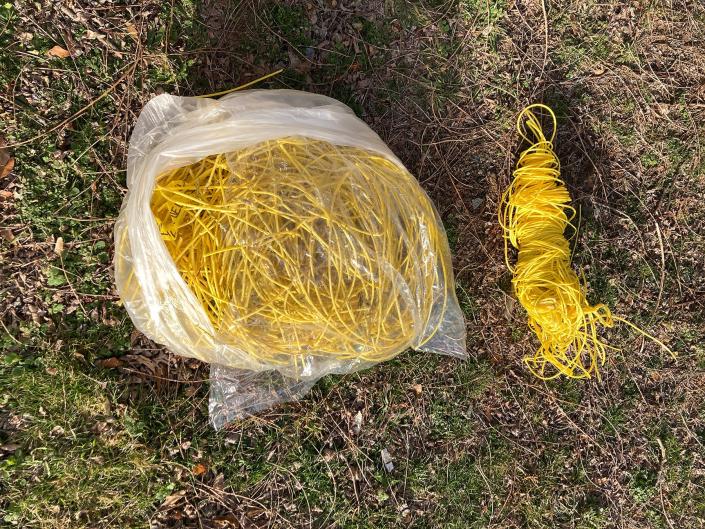When a veteran beach clean-up expert noticed a bloom of yellow plastic tubing along Outer Cape strands, she began to ask questions.
“I had never seen it before,” said Laura Ludwig, manager of the Center for Coastal Studies Marine Debris and Plastics Program. “Where was it coming from?”
Thus began a journey to unravel the stringy mystery. Ludwig first encountered the tubing in September 2021 at Long Point in Provincetown during a beach clean-up. During the days that followed, more of the plastic was picked off beaches in Outer Cape towns.
“It was mind-blowing how much of the stuff there was,” she said in a recent phone interview.

The yellow tubing has a thin rope-like appearance, and continues to wash up on Cape Cod beaches in varying lengths, from very short (1 millimeter) to 90 feet. Ludwig said it has been found on beaches in Provincetown, Truro, Wellfleet, Orleans, Brewster and Yarmouth. It has also been found on beaches in Hull, Scituate and beyond.
“I found a piece in Newport, Rhode Island last week,” said Ludwig.
Where is the plastic washing up on Cape shores coming from?
So far, Ludwig’s beach cleanups and other volunteer efforts have plucked more than 2,000 feet of the tubing from Cape beaches.
Picking up beach debris is no easy task, but determining where it came from can also be a tall order. Because of its sudden appearance, Ludwig figured the tubing must have been related to a new situation, perhaps a recent project or unusual occurrence. She reached out to beach debris colleagues, asking for assistance on the mystery.
One of those colleagues posted a picture of the tubing on Facebook.
According to Ludwig, someone from the United Kingdom said it looked similar to material used in blasting rocks in quarries.
This explosive theory led Ludwig to reach out to the U.S. Army Corps of Engineers, to see if similar tubing had been used in projects in the region.
The answer, according to Ludwig was “yes.”

The tubing on the beaches came from a Boston Harbor dredging project that began in June 2021 and concluded in January 2022.
Known as explosive shock tubing, the yellow plastic strand is used to transmit a signal to explosives. In this case, the explosives were underwater, placed to break up rocks as the harbor channel was deepened.
According to Ludwig, the contractor involved with the project did have a containment strategy, with vessels on the surface picking up the tubing as it floated to the surface, but some escaped, likely mixed in with rocky debris.
Photo gallery: Sandwich Boardwalk damaged by storm
Ludwig said both the U.S. Army Corps of Engineers and the contractor are seeking ways to improve containment on future projects. To deal with the current situation, Ludwig is organizing a beach clean-up along the Boston Harbor shoreline in collaboration with the Corps and the contractor.
“Plastic: A Personal History”: Cape Cod Poetry judges, including Elizabeth Bradfield, share some of their own works
The U.S. Army Corps of Engineers did not immediately respond to a phone message and email seeking comment about the debris.
According to a press release from the Center for Coastal Studies, “the shock tube is made out of low‐density polyethylene (the same plastic used to make grocery bags) and is considered safe for humans to touch. But many of the pieces are small enough for birds or other animals to eat and can create health problems if ingested.”
PFAS in lobsters? Another sign these harmful compounds are everywhere, researchers say
Cape Cod beachcombers may recall a somewhat similar situation in 2011, when a New Hampshire wastewater treatment plant accidentally released millions of small plastic discs, with many ending up on area beaches. Ludwig said she still finds those disks along Cape beaches.
Ludwig is working with oceanographers at the Center for Coastal Studies and NOAA’s Northeast Fisheries Science Center in Woods Hole on drift models that may help predict where the tubing will come ashore. She is also asking for help from people who find the tubing on the beach.
Reports of shock tube location and length can be emailed to Ludwig at lludwig@coastalstudies.org.
‘Things are worse’: Cape Cod water quality is declining, says environmental group’s report
Over the years, Ludwig has become more concerned over the amount of plastic in our region’s waters and on the beaches.
“These are things that never go away,” she said. “We find plastic lobster trap tags from the 1990s.”
This article originally appeared on Cape Cod Times: Plastic tubing washing up on Cape Cod beaches likely from Boston